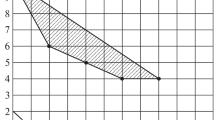Abstract
We propose a relatively simple and efficient method for solving the problem of analytic construction of optimal regulators for multidimensional control objects with polynomial nonlinearities based on the A.A. Krasovskii’s generalized work criterion. Our method employs an extension of the power series method which is based on using matrix theory with Kroneker (direct) product. The matrix formalism has let us establish a simple recursive relation for the matrices of coefficients of the Bellman-Lyapunov function, with which the control problem can be solved with any reasonable precision on modern computers.
Similar content being viewed by others
References
Spravochnik po teorii avtomaticheskogo upravleniya (Automated Control Theory Reference), Krasovskii, A.A., Ed., Moscow: Nauka, 1987.
Kolesnikov, A.A., Krasovskii, A.A., Bukov, V.N., et al., Sovremennaya prikladnaya teoriya upravleniya (Modern Applied Control Theory), 3 vols., Taganrog: TRTU, 2000.
Porter, W.A., An Overview of Polynomic System Theory, Proc. IEEE, 1976, vol. 64, no. 1, pp. 36–44.
Sage, A.P. and White, C.C., Optimum Systems Control, Englewood Cliffs: Prentice Hall, 1977. Translated under the title Optimal’noe upravlenie sistemami, Moscow: Radio i Svyaz’, 1982.
Afanas’ev, V.N., Kolmanovskii, V.B., and Nosov, V.R., Matematicheskaya teoriya konstruirovaniya sistem upravleniya (The Mathematical Theory of Constructing Control Systems), Moscow: Vysshaya Shkola, 1998.
Krasovskii, A.A., Bukov, V.I., and Shendrik, V.S., Universal’nye algoritmy optimal’nogo upravleniya nepreryvnymi ob”ektami (Universal Optimal Control Algorithms for Continuous Objects), Moscow: Nauka, 1977.
Bukov, V.N., Adaptivnye prognoziruyushchie sistemy upravleniya poletom (Adaptive Forecasting Systems of Flight Control), Moscow: Nauka, 1987.
Lancaster, P., Theory of Matrices, New York: Academic, 1969. Translated under the title Teoriya matrits, Moscow: Nauka, 1982.
Voevodin, V.V. and Kuznetsov, Yu.A., Matritsy i vychisleniya (Matrices and Computation), Moscow: Nauka, 1984.
Lovchakov, V.I., The Method of Analytical Design of Quasi-Optimal Control Systems with Polynomial Nonlinearities, Autom. Remote Control, 2007, vol. 68, no. 6, pp. 979–992.
Lovchakov, V.I., Suhinin, B.V., Kirpa, A.V., and Lukashin, O.V., A New Description Form for Nonlinear Objects and Optimal Control Problems, in Tr. Tulsk. Gos. Univ., Ser. Vychisl. Tekhn., Inform. Tekhnol., tom 3: Sist. Upravlen. (Proc. Tula State Univ., Ser. Comput. Technics, Inform. Tech., vol. 3: Control Systems), 2006, vol. 2, pp. 12–15.
Averina, A.D. and Modyaev, A.D., Studies of Nonlinear Control Systems Based on Discrete Modeling, Diskretnye nelineinye sistemy (Discrete nonlinear systems), Topcheev, Yu.I., Ed., Moscow: Mashinostroenie, 1982.
Author information
Authors and Affiliations
Additional information
Original Russian Text © V.I. Lovchakov, E.V. Lovchakov, 2011, published in Avtomatika i Telemekhanika, 2011, No. 7, pp. 96–106.
Rights and permissions
About this article
Cite this article
Lovchakov, V.I., Lovchakov, E.V. Matrix power series method for nonlinear problems of optimal regulator construction. Autom Remote Control 72, 1440–1449 (2011). https://doi.org/10.1134/S0005117911070125
Received:
Published:
Issue Date:
DOI: https://doi.org/10.1134/S0005117911070125



